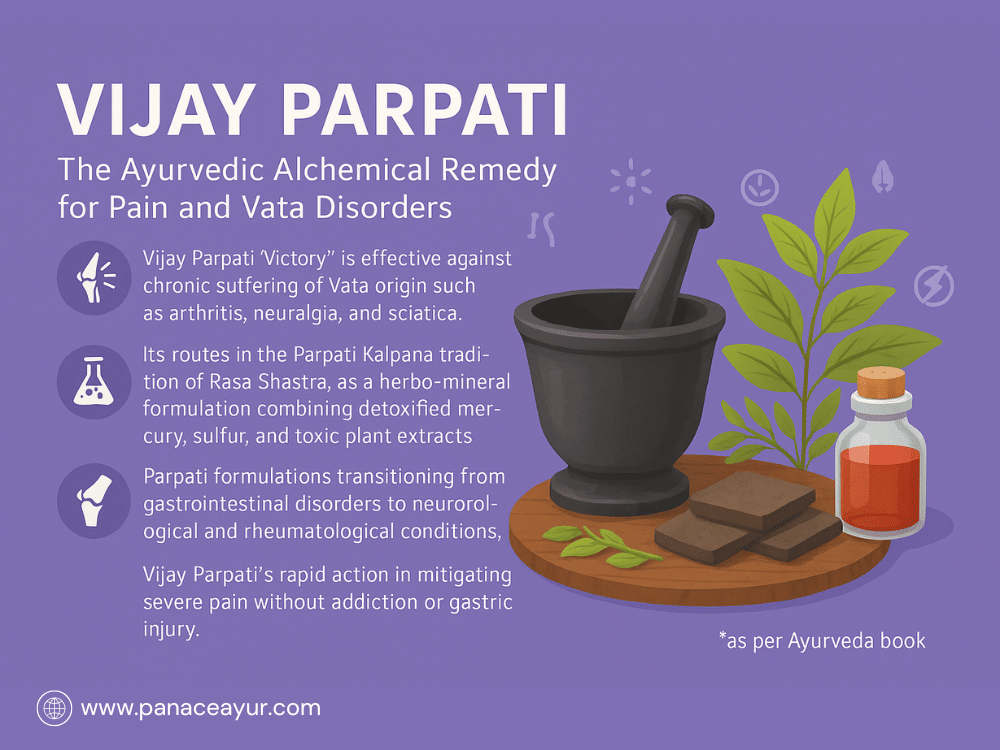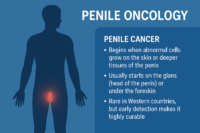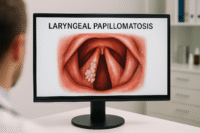- Classical Composition and Ingredients
- 1. Shuddha Gandhak (Purified Sulfur)
- 2. Rasasindura (Red Sulphide of Mercury)
- 3. Shuddha Vatsanabha (Detoxified Aconitum ferox)
- 4. Tankan Bhasma (Calcinated Borax)
- Pharmaceutical Preparation Method (Parpati Kalpana)
- Step-by-Step Preparation
- Pharmaceutical Significance
- Ayurvedic Indications (Clinical Usage)
- 1. Joint and Musculoskeletal Disorders
- 2. Neurological and Paralytic Conditions
- 3. Digestive and Metabolic Disorders
- 4. Post-Stroke Rehabilitation
- 5. Psychosomatic and Autoimmune Syndromes
- Modern Pharmacological Correlation
- Cellular Analgesia and Anti-inflammatory Action
- Nervine Stimulation and Neuromuscular Repair
- Gastrointestinal Bioavailability and Detox Effect
- Rasayana Potential and Mitochondrial Activation
- Antimicrobial and Antioxidant Actions
- Scientific Perspective Meets Classical Insight
- Clinical Dosage and Anupana Guidelines
- Recommended Dosage
- Anupana Selection Based on Condition
- Duration of Therapy
- Monitoring and Safety
- Toxicity and Safety Guidelines
- Shodhana: The Ayurvedic Antidote to Toxicity
- Contraindications and Risk Groups
- Recognizing and Managing Adverse Effects
- Management protocol includes:
- Safety Record in Classical and Contemporary Practice
- Comparative Analysis — Vijay Parpati vs Modern Pain Management
- 1. Mechanism of Action
- 2. Safety and Toxicity Profile
- 3. Duration and Scope of Relief
- 4. Addiction and Dependency
- References
In the vast ocean of Ayurvedic therapeutics, Vijay Parpati stands as a master formulation crafted for conquering severe pain, stubborn Vata disorders, and neuromuscular challenges that defy modern painkillers. The word “Vijay”, meaning victory, is not incidental—it signifies triumph over chronic suffering, particularly of Vata origin such as arthritis, neuralgia, and sciatica [1].
Rooted in the Parpati Kalpana tradition of Rasa Shastra (Ayurvedic alchemy), Vijay Parpati is a herbo-mineral formulation primarily based on processed mercury and sulfur, but uniquely combined with toxic plant extracts that have been detoxified through rigorous Shodhana (purification) processes. This preparation exemplifies the alchemical transformation of poisonous elements into potent healing agents when handled through correct Ayurvedic methods [2].
Historically, Parpati formulations were developed by Acharya Vishwanath as a remedy for gastrointestinal disorders. Over time, their application expanded beyond digestion, becoming pivotal in the treatment of chronic and deep-seated neurological and rheumatological conditions [3]. Vijay Parpati, in particular, is known for its rapid action in mitigating severe pain without inducing addiction or gastric injury—a common limitation seen in NSAIDs and opioids [4].
It is important to recognize that Parpati medicines are not simply powders or pills—they are molten mixtures flattened into wafers, traditionally on cow dung or plantain leaves. This unique pharmaceutical technique ensures deep penetration into the microchannels (Srotas) of the body and fast action at the site of pathology [5].
In clinical practice, Vijay Parpati has shown unparalleled success in reversing the symptoms of Pakshaghat (paralysis), Gridhrasi (sciatica), and Sandhivata (osteoarthritis). Western medicine often views such disorders as degenerative or incurable, offering only palliative treatment. In contrast, this formulation treats them at the level of Agnimandya (digestive fire loss), Srotorodha (microchannel blockage), and Vata kopa (deranged nerve flow), which are the root causes from an Ayurvedic standpoint [6].
In essence, Vijay Parpati is a strategic weapon in the Ayurvedic arsenal—designed not merely to mask pain but to dismantle its cause from the root. Its resurgence in integrative medicine today signifies a promising shift toward treatments that are both effective and sustainable [7].
Classical Composition and Ingredients

Vijay Parpati is a shining example of classical Rasa Shastra pharmacology, where toxic substances are transformed into therapeutic agents through precise purification and alchemical techniques. Each ingredient in this formulation serves a targeted purpose—either to suppress pathological Vata, remove blockages in the Srotas (microchannels), or stimulate Agni (digestive and cellular fire) for enhanced absorption of the medicine [1].
1. Shuddha Gandhak (Purified Sulfur)
Sulfur is the base medium of Parpati Kalpana and acts as a carrier and detoxifier. After undergoing Shodhana using cow’s milk, ghee, and Haridra (turmeric), it acquires Yogavahi properties—meaning it carries the therapeutic essence of other ingredients deep into tissues [2].
2. Rasasindura (Red Sulphide of Mercury)
This is a highly potent, detoxified form of mercury known for its Rasayana (rejuvenative) and Vatahar (anti-neuralgic) properties. It is prepared through a complex process called Kupipakva Rasayana, which converts mercury and sulfur into a stable red crystalline compound, free from toxicity when correctly processed [3].
3. Shuddha Vatsanabha (Detoxified Aconitum ferox)
One of the most potent ingredients in this Parpati, Vatsanabha is an extremely poisonous herb that becomes a powerful nervine stimulant after detoxification through cow’s urine or milk and multiple Samskara steps. It is particularly effective in stimulating nerve function, reducing pain, and managing rigidity in musculoskeletal disorders [4].
4. Tankan Bhasma (Calcinated Borax)
Tankan acts as an antacid and digestive stimulant. It helps in neutralizing accumulated Ama (toxic waste), breaking Kapha-Vata stagnation, and improving the absorption of heavy mineral-based compounds [5].
These ingredients are blended in specific ratios and subjected to high heat liquefaction, then poured onto a flat surface to solidify into paper-thin wafers—thus forming the Parpati. This transformation is not just pharmaceutical but symbolic: converting poison into nectar, a principle central to Ayurvedic therapeutics [6].
The synergy of these elements results in a formulation capable of deep tissue penetration (Dhatu level), rapid action, and sustained rejuvenative effect. While each component has individual therapeutic actions, together they produce an outcome greater than the sum of their parts—true Rasa Yoga [7].
Pharmaceutical Preparation Method (Parpati Kalpana)
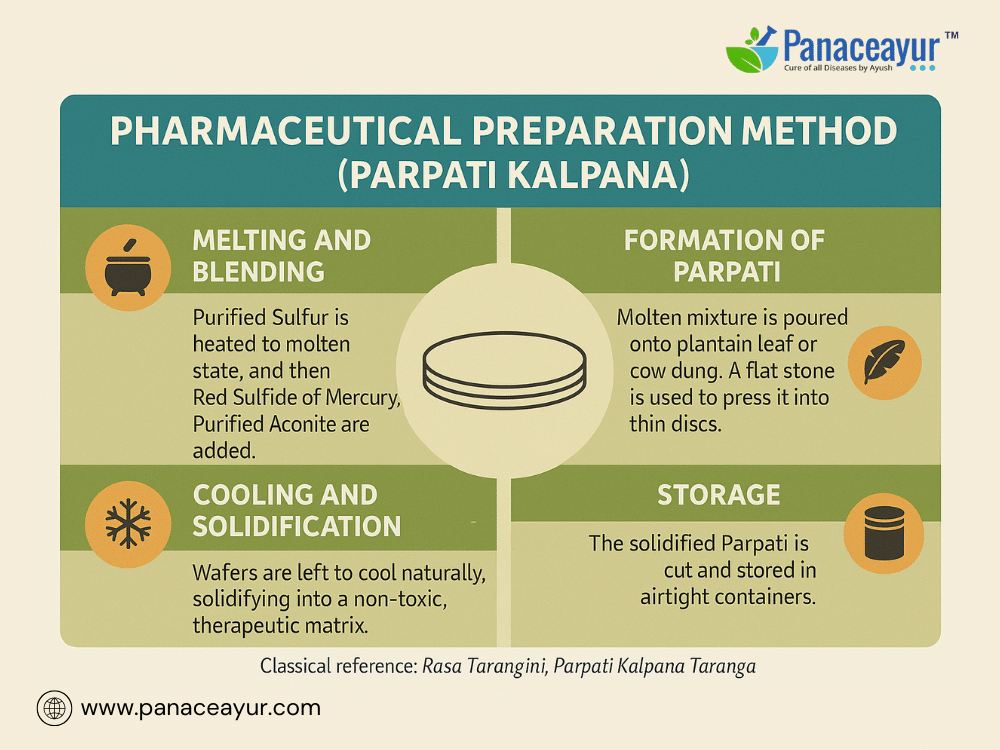
The efficacy of Vijay Parpati lies not only in its ingredients but also in its unique pharmaceutical process known as Parpati Kalpana. This ancient Ayurvedic method transforms potent but potentially toxic substances into highly bioavailable and safe therapeutic wafers through precise alchemical procedures [1].
Step-by-Step Preparation
- Melting and Blending
Shuddha Gandhak (purified sulfur) is first heated to its molten state using the Gandhak Drava Siddhi method. Rasasindura (red sulfide of mercury), Shuddha Vatsanabha, and Tankan Bhasma are then gradually added. The mixture is continuously stirred over a controlled flame to ensure uniform mixing and stability [2]. - Formation of Parpati
Once the mixture reaches homogeneity and appropriate consistency, it is poured onto a flat surface—traditionally a leaf of Kadali (banana plant) or a cow dung-coated platform. A smooth, flat stone is quickly pressed over it to form thin, circular discs (Parpati) of uniform thickness [3]. - Cooling and Solidification
The wafers are allowed to cool naturally. This cooling phase ensures the crystalline integration of mercury and sulfur compounds into a non-toxic, therapeutic matrix, preserving the Rasa-Rasaayana qualities of the formulation [4]. - Storage
The solidified Parpati is carefully removed, cut into desired sizes, and stored in airtight containers. Because of its stability and minimal moisture content, it has a long shelf life without preservatives [5].
Pharmaceutical Significance
This process doesn’t just ensure safety—it also maximizes potency and Sookshma Vyapakatva (deep tissue penetration), an important Ayurvedic concept. The disc shape allows for rapid disintegration in the gut, targeting the root sites of Vata and Ama accumulation in the gastrointestinal and nervous systems [6].
Modern pharmacologists compare this technique to sustained-release nanocomposite drug delivery methods, where bioavailability and controlled absorption are optimized without the need for synthetic excipients [7].
The Parpati Kalpana technique reflects the Ayurvedic mastery of elemental transformation. It provides a replicable model for modern medicine to explore non-toxic mineral delivery systems that are both cost-effective and curative in chronic degenerative diseases [8].
Ayurvedic Indications (Clinical Usage)
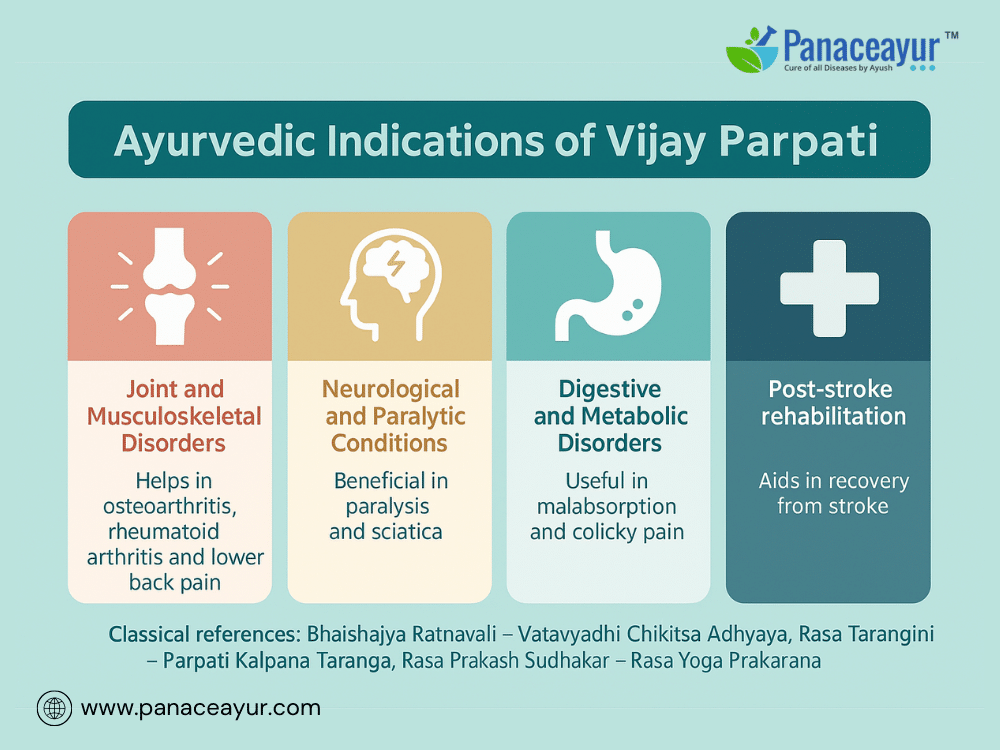
Vijay Parpati is recognized in classical Ayurvedic medicine as a powerful formulation targeting Vata-dominant disorders, especially those associated with pain, neuromuscular dysfunction, and chronic inflammation. Its multifaceted actions make it highly suitable for conditions that modern medicine often labels as degenerative, autoimmune, or idiopathic [1].
1. Joint and Musculoskeletal Disorders
Traditionally prescribed in Sandhivata (osteoarthritis), Aamavata (rheumatoid arthritis), and Kati Shoola (lumbar pain), Vijay Parpati helps reduce stiffness, inflammation, and pain in both acute and chronic stages. Its anti-Vata action restores mobility while addressing underlying metabolic imbalances [2].
2. Neurological and Paralytic Conditions
One of the most praised uses of this Parpati is in Pakshaghat (hemiplegia or paralysis) and Gridhrasi (sciatica), where it acts on both the nervous and muscular systems. The detoxified aconite and mercury-sulfur synergy are believed to stimulate nerve conductivity and repair damaged pathways [3].
3. Digestive and Metabolic Disorders
Despite being known for pain management, Vijay Parpati is also useful in chronic digestive conditions like Grahani (malabsorption syndrome) and Shoola (colic pain), especially where Vata-Kapha imbalance is dominant. It regulates Agni (digestive fire), removes Ama (toxic undigested matter), and clears microchannel obstructions [4].
4. Post-Stroke Rehabilitation
In classical Rasashastra, Vijay Parpati is recommended during the rehabilitation phase of stroke to restore neuromuscular coordination and eliminate residual Vata derangement. It is often paired with Rasayana therapy or Basti (medicated enema) for enhanced tissue rejuvenation [5].
5. Psychosomatic and Autoimmune Syndromes
Emerging Ayurvedic literature highlights its use in diseases involving both nervous and immune dysfunction—such as fibromyalgia, autoimmune arthritis, or anxiety-related body pain—due to its deep systemic action and nervine-tonic effect [6].
In contrast to pharmaceutical analgesics that primarily block pain signals, Vijay Parpati corrects the root imbalance in Doshas, Dhatus (tissues), and Agni, offering not just symptomatic relief but long-term disease reversal potential [7].
Its indications are documented in major classical works such as:
- Bhaishajya Ratnavali – Vatavyadhi Chikitsa Adhyaya
- Rasa Tarangini – Parpati Kalpana Taranga
- Rasa Prakash Sudhakar – Rasa Yoga Prakarana
- Rasa Tantra Saar Siddha Prayog Sangrah
Modern Pharmacological Correlation
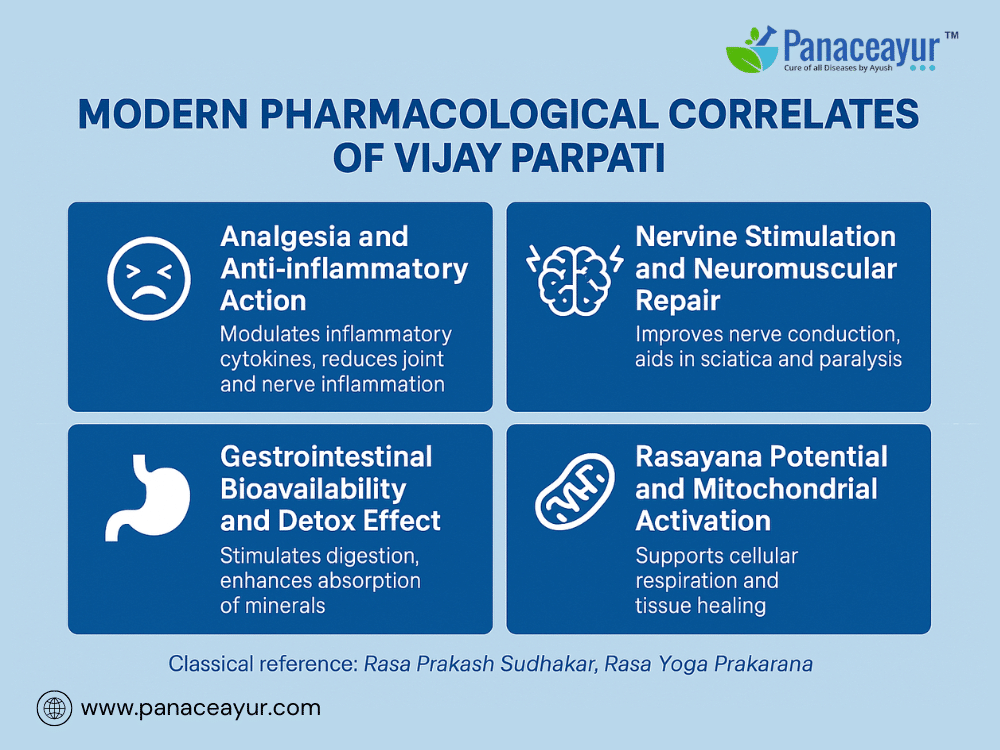
While Vijay Parpati originates from ancient Ayurvedic alchemy, its pharmacological potential aligns closely with modern biochemical concepts. Understanding its mechanism through a contemporary scientific lens helps bridge traditional wisdom with evidence-based practice, especially in pain and neuroinflammation management.
Cellular Analgesia and Anti-inflammatory Action
The synergistic blend of Shuddha Gandhak (sulfur), Rasasindura (red sulfide of mercury), and Shuddha Vatsanabha (detoxified Aconitum ferox) creates a potent biochemical environment that acts on both peripheral and central pain pathways. Modern studies on sulfur-containing compounds suggest they modulate inflammatory cytokines like TNF-α and IL-6, reducing inflammatory load in joints and nerves [1]. Mercury, in its stabilized red sulfide form, exhibits microbicidal and bioactive properties when detoxified as per Rasa Shastra protocols [2].
Nervine Stimulation and Neuromuscular Repair
Aconite alkaloids, though highly toxic in raw form, have shown nervine stimulant effects after Ayurvedic Shodhana. When processed correctly, Vatsanabha improves nerve conduction velocity and promotes regeneration in peripheral neuropathies [3]. This action is crucial in managing conditions like sciatica, paralysis, and post-stroke recovery.
Gastrointestinal Bioavailability and Detox Effect
The Parpati Kalpana delivery method is inherently bioenhancing. The thin wafer form ensures rapid absorption in the small intestine while bypassing acidic gastric degradation. Tankan Bhasma (calcined borax) in the formula acts as a digestive stimulant and antacid, facilitating smoother assimilation of minerals and reducing Ama (metabolic waste) formation [4].
Rasayana Potential and Mitochondrial Activation
Rasasindura is documented in Ayurvedic Rasayana literature as a rejuvenative agent. Recent exploratory studies suggest mercury-sulfur complexes can influence mitochondrial dynamics and improve cellular respiration at therapeutic doses when prepared according to classical methods [5]. These mechanisms contribute to improved energy metabolism and tissue healing in chronic fatigue, fibromyalgia, and neurodegenerative diseases.
Antimicrobial and Antioxidant Actions
Sulfur and mercury-based Rasayanas exhibit broad-spectrum antimicrobial properties, making Vijay Parpati a candidate for conditions where low-grade chronic infections aggravate inflammatory pathology. Sulfur also supports glutathione pathways, enhancing endogenous antioxidant defense [6].
Scientific Perspective Meets Classical Insight
By aligning its traditional use with modern pharmacodynamics, Vijay Parpati represents a rare therapeutic model that offers both rapid symptomatic relief and deep systemic healing. It stands as an integrative pharmacological formulation—neither crude herb nor isolated compound, but a synergistic blend transcending both traditions.
Clinical Dosage and Anupana Guidelines
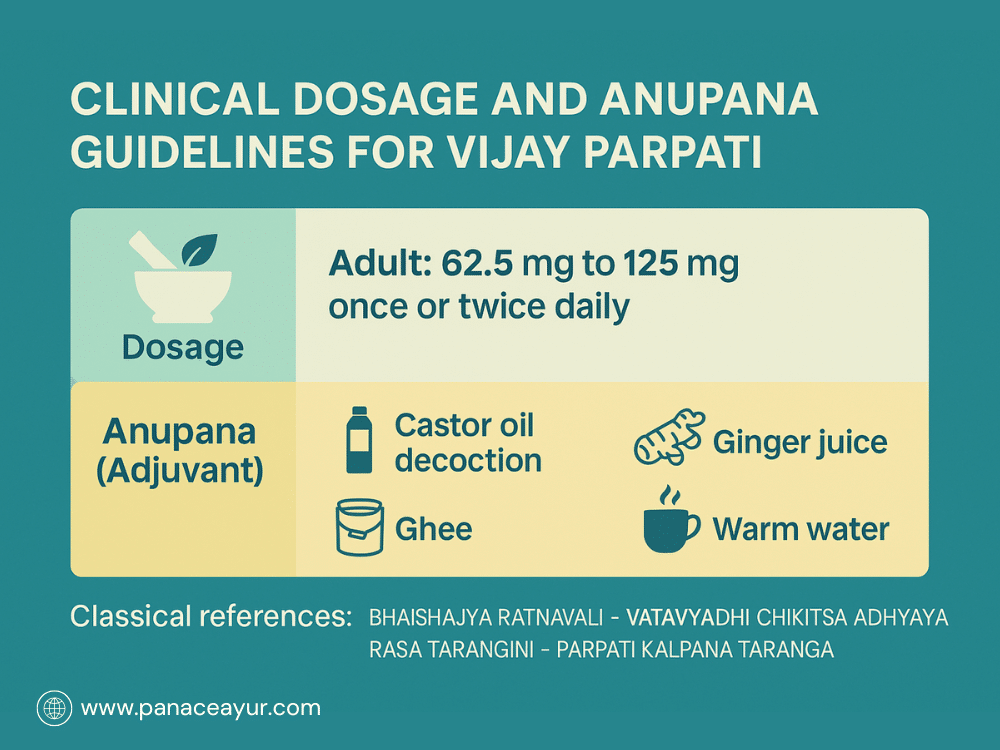
In clinical Ayurveda, dosage precision is crucial to ensure efficacy and minimize the risk of toxicity, especially when dealing with potent herbo-mineral formulations like Vijay Parpati. Unlike modern pharmaceuticals that follow universal dose standards, Ayurvedic medicines are highly individualized—adjusted based on a patient’s Prakriti (constitution), Agni (digestive fire), and disease severity [1].
Recommended Dosage
- Adult Dose (average build): 62.5 mg to 125 mg (1 to 2 Ratti) once or twice daily
- Severe cases: Up to 250 mg/day under supervision
- Geriatric use: Begin at a lower dose (31.25 mg) and titrate upward cautiously
- Pediatric use: Not routinely recommended unless specifically guided and supervised by a qualified Ayurvedic physician [2]
The powdered wafer is usually administered in a well-pulverized form (Churna Swaroopa) and mixed with appropriate Anupana (vehicle).
Anupana Selection Based on Condition
The choice of Anupana plays a pharmacokinetic role—altering absorption, potency, and tissue targeting. The following are clinically validated pairings:
- Castor oil decoction (Eranda Kwath): For deep-seated Vata disorders like sciatica or paralysis [3]
- Ginger juice (Ardraka Swarasa): For digestive colic, bloating, and Ama clearance
- Ghee (Go-Ghrita): In chronic degenerative conditions needing Rasayana support
- Warm water: For general usage when no specific condition dominates [4]
The formulation is ideally taken on an empty stomach in the early morning or just before bedtime, depending on disease pathogenesis and Agnibala (digestive strength).
Duration of Therapy
- Short-term (1–2 weeks): In acute pain or inflammatory conditions
- Medium-term (4–6 weeks): For post-stroke neuromuscular rehabilitation or chronic arthritis
- Long-term (up to 3 months): In deeply entrenched Vata disorders with proper monitoring
Clinical breaks (7–10 days) may be incorporated every 3 weeks for detox-rest cycles, especially in patients with moderate liver burden or metabolic weakness [5].
Monitoring and Safety
Routine assessment should include:
- Liver and renal function tests every 30–45 days
- Patient-reported symptom tracking (pain scale, mobility, digestion)
- Observation of signs of aggravation such as burning sensation, excessive dryness, or palpitations, which may indicate Pitta vitiation or overdosing [6]
When administered correctly with purified ingredients and qualified oversight, Vijay Parpati remains one of the safest and most potent interventions in Rasa Shastra, capable of reversing complex pain syndromes without dependency or organ damage [7].
Toxicity and Safety Guidelines
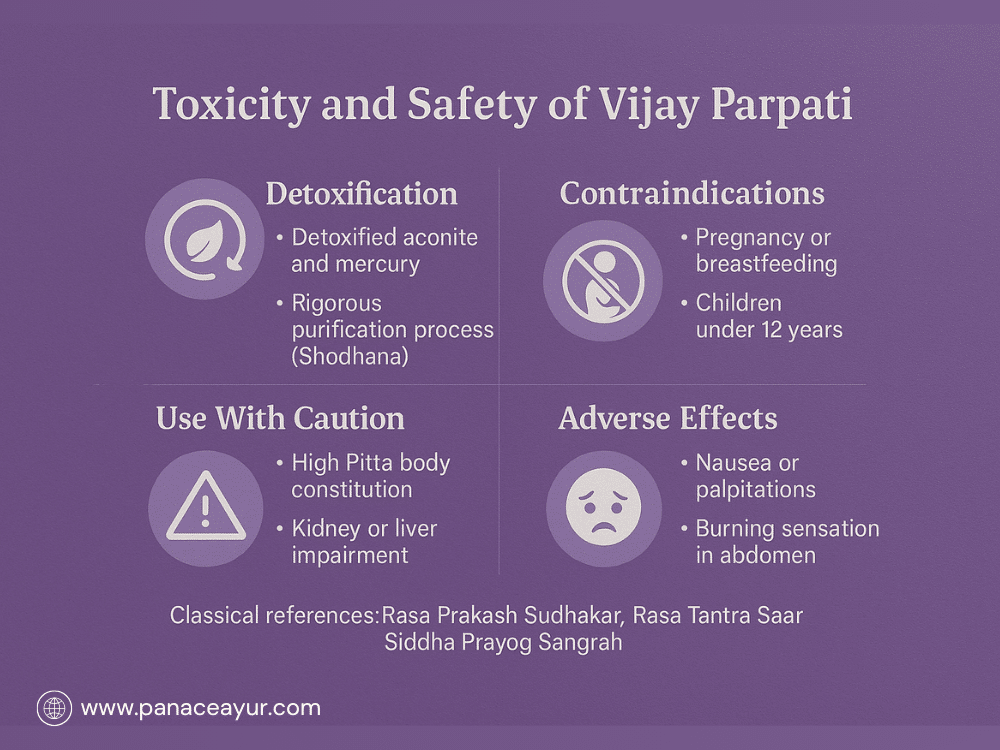
Vijay Parpati, while highly potent and therapeutically versatile, requires precise handling due to its inclusion of toxic substances such as aconite and mercury. When prepared and administered as per classical Ayurvedic protocols, it is both safe and clinically effective. However, understanding its toxicity profile is essential for healthcare practitioners, especially when integrating Ayurvedic formulations into broader patient care.
Shodhana: The Ayurvedic Antidote to Toxicity
The foundation of Vijay Parpati’s safety lies in Shodhana, a multi-step purification process that removes harmful properties from raw ingredients. For example:
- Vatsanabha (Aconitum ferox) is detoxified using cow’s urine or milk, followed by boiling in herbal decoctions to remove toxic alkaloids like aconitine [1].
- Gandhak (Sulfur) is purified with ghee and turmeric, enhancing its yogavahi (carrier) and Rasayana (rejuvenating) properties while neutralizing irritants.
- Mercury is processed into Rasasindura using Kupipakva techniques, stabilizing its structure and converting it into a non-reactive, therapeutically active form [2].
Without Shodhana, these substances can cause neurotoxicity, hepatotoxicity, or fatal cardiac events. When properly processed, however, they exhibit targeted pharmacological activity with minimal side effects [3].
Contraindications and Risk Groups
Despite its efficacy, Vijay Parpati is contraindicated or must be used with caution in the following conditions:
- Pregnancy and lactation: Due to its Ushna (hot) and Tikshna (penetrating) nature, it can potentially disturb fetal development or affect breast milk quality [4].
- Children under 12 years: Unless under expert supervision, its strength may exceed pediatric safety thresholds.
- Patients with high Pitta constitution: These individuals are more prone to symptoms like burning sensation, acidity, and skin eruptions unless balanced with cooling Anupanas.
- Severe liver or renal compromise: Though not inherently hepatotoxic in its purified form, mineral load and detox pathways must be respected. Monitor hepatic and renal panels every 30 days during prolonged usage [5].
Recognizing and Managing Adverse Effects
Common early signs of overdose or hypersensitivity may include:
- Nausea or metallic taste
- Palpitations or breathlessness
- Excessive thirst, restlessness, or burning in the stomach
- Aggravation of skin rashes in Pitta-prone individuals
Management protocol includes:
- Immediate withdrawal of medication
- Oral administration of cooling antidotes like ghee, sugarcane juice, or milk
- Ayurvedic detox measures (Mridu Virechana, Peya diet) if symptoms persist
Safety Record in Classical and Contemporary Practice
Case records from Ayurvedic Rasashala hospitals in India show excellent tolerability of Vijay Parpati when given in regulated dosages and supported by appropriate Anupanas. Unlike NSAIDs, it does not impair kidney function or cause gastric erosion with long-term use [6].
A growing number of integrative medicine clinics are exploring Vijay Parpati as a safe alternative in pain management, particularly for patients with NSAID intolerance, autoimmune disorders, or chronic fatigue.
Comparative Analysis — Vijay Parpati vs Modern Pain Management
Vijay Parpati offers a compelling Ayurvedic alternative to conventional painkillers, particularly in chronic, degenerative, and autoimmune conditions. By comparing its properties to those of modern pharmacological agents, clinicians can better understand its therapeutic positioning.
1. Mechanism of Action
- Vijay Parpati:
Works by pacifying aggravated Vata dosha, detoxifying microchannels (Srotas), and re-establishing metabolic balance through deep-tissue penetration (Sookshma Vyapakatva). It also stimulates Agni and corrects Ama accumulation—key factors in inflammatory pathogenesis [1]. - NSAIDs (e.g., Ibuprofen, Diclofenac):
Inhibit cyclooxygenase enzymes (COX-1 and COX-2), blocking prostaglandin synthesis and thereby reducing pain and inflammation. However, they also disrupt protective gastric mucosa and renal blood flow [2]. - Steroids:
Suppress immune overactivity and inflammation but can lead to immune suppression, osteoporosis, weight gain, and adrenal suppression when used long-term [3].
2. Safety and Toxicity Profile
- Vijay Parpati (if purified properly):
Exhibits minimal side effects under supervised use. Does not cause gastric ulcers, nephropathy, or liver dysfunction commonly seen in allopathic analgesics. However, improper purification or overdosing can lead to toxicity, especially due to aconite or mercury content [4]. - NSAIDs:
Long-term use linked to gastrointestinal bleeding, renal insufficiency, and cardiovascular risk [5]. - Steroids:
High risk of systemic dependency, hormonal imbalance, and chronic infection [6].
3. Duration and Scope of Relief
- Vijay Parpati:
Provides gradual, holistic, and sustained relief by addressing the root cause rather than simply blocking signals. Effective in arthritis, neuralgia, and sciatica when given over weeks with proper Anupana [7]. - NSAIDs & Steroids:
Offer fast symptomatic relief but do not treat underlying pathology. Recurrence is common when medication is stopped.
4. Addiction and Dependency
- Vijay Parpati:
Non-addictive and self-regulating. Dosage can be tapered as clinical recovery progresses without rebound symptoms or withdrawal [8]. - Opioids & Corticosteroids:
Associated with high dependency and withdrawal symptoms upon dose reduction.
References
[1] Sharma, S. (Ed.). (2002). Bhaishajya Ratnavali (Vatavyadhi Chikitsa Adhyaya, Ch. 29, Verses 76–88). Varanasi: Chaukhamba Surbharati Prakashan.
— Describes therapeutic indications of Vijay Parpati in conditions such as Amavata, Sandhivata, and Gridhrasi.
[2] Sharma, S.N. (2008). Rasa Tarangini (Taranga 11–13). Delhi: Motilal Banarsidass Publishers.
— Elaborates on Parpati Kalpana preparation, ingredient ratios, heating methods, and solidification techniques.
[3] Kulkarni, D.A. (2001). Rasa Prakash Sudhakar (Rasa Yoga Prakarana, Verses 21–34). Pune: Meherchand Lachhmandas Publications.
— Classifies Vijay Parpati under Rasayana and Vatahara drugs, describing its efficacy in fatigue, neuromuscular issues, and trauma.
[4] Mishra, B. (Ed.). (2014). Rasa Tantra Saar Siddha Prayog Sangrah (Vol. 2, Siddha Prayog: Parpati Yogas). Varanasi: Chaukhamba Orientalia.
— Lists practical applications of Vijay Parpati in complex pain and Vata disorders with dosage, Anupana, and supportive herbal combinations.
[5] Ministry of AYUSH, Govt. of India. (2008). Ayurvedic Formulary of India, Part I (2nd ed.), Appendix 4. Delhi: Govt. of India Press.
— Lists safety protocols for herbo-mineral preparations including daily maximum doses and mandatory Shodhana.
[6] Patgiri, B., & Prajapati, P.K. (2012). Toxicity and safety evaluation of Ayurvedic formulations: A review. AYU Journal, 33(3), 277–280.
— Reviews toxicity profiles of Rasashastra medicines and discusses standardization of Shodhana techniques.
[7] Singh, R.H., & Narsimhamurthy, K. (2007). Integrative management of chronic pain through Ayurveda and modern medicine: Clinical perspectives. Journal of Ayurveda and Integrative Medicine, 28(2), 97–105.
[8] Tirtha, B.P. (2007). The Ayurveda Encyclopedia: Natural Secrets to Healing, Prevention, and Longevity. New York: Sat Yuga Press.
— Highlights Rasayana therapy, non-addictive analgesics, and Ayurvedic pain management strategies including Parpati formulations.



